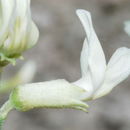Comprehensive Description
(
Inglês
)
fornecido por North American Flora
Tium atratum (S. Wats.) Rydberg
Astragalus alratus S. Wats. Bot. King's Expl. 69. 1871.
Tragacantha atrata Kuntze. Rev. Gen. 943. 1891.
Astragalus alratus stenophyllus M. E. Jones, Zoe 3: 297. 1893.
Astragalus atralus arclus Sheldon, Minn. Bot. Stud. 1: 160. 1894.
Astragalus atratus phyllophorus M. E. Jones, Contr. W. Bot. 10: 62. 1902.
Hamosa atrata Rydb. Bull. Torrey Club 34: 48. 1907.
A perennial, with a woody root and short caudex; stems ascending, slender, 1-3 dm. high, strigose or glabrate; leaves ascending, 4-10 cm. long; stipules deltoid, 2 mm. long; leaflets 9-15, linear or oblong, 4-15 mm. long, 1-2 mm. wide, obtuse, strigose on both sides or glabrate above; peduncles 5-15 cm. long; racemes 3-5 cm. long, rather lax; brads lanceolate, 2 mm. long; pedicels 2-4 mm. long, recurved; calyx black-hairy, the tube 4 mm. long, 2 mm. wide, the teeth lance-subulate, 1.5-2 mm. long; corolla white, 8-10 mm. long; banner ovate, strongly arched, notched, purple-striate; wings fully as long, the blade oblong, usually 2-lobed at the apex; keel-petals shorter, the blade broadly lunate, nearly semiorbicular, more strongly arched at the middle; pod pendulous, short-stipitate, linear, 1.5-2 mm. long, 2-2.5 mm. wide and thick, strigose, slightly sulcate on the upper suture, the septum nearly meeting the upper suture.
Type locality: Pah-Ute Range, Nevada. Distribution: Nevada.
- citação bibliográfica
- Per Axel Rydberg. 1919. (ROSALES); FABACEAE; PSORALEAE. North American flora. vol 24(1). New York Botanical Garden, New York, NY
Physical Description
(
Inglês
)
fornecido por USDA PLANTS text
Perennial, Herbs, Stems woody below, or from woody crown or caudex, Taproot present, Nodules present, Stems erect or ascending, Stems or branches arching, spreading or decumbent, Stems prostrate, trailing, or mat forming, Stems less than 1 m tall, Stems solid, Stems or young twigs sparsely to densely hairy, Stem hairs hispid to villous, Leaves alternate, Leaves petiolate, Stipules conspicuous, Stipules membranous or chartaceous, Stipules persistent, Stipules free, Leaves compound, Leaves odd pinnate, Leaf or leaflet margins entire, Leaflets opposite, Leaflets 5-9, Leaflets 10-many, Leaves hairy on one or both surfaces, Inflorescences racemes, Inflorescence axillary, Bracts very small, absent or caducous, Flowers zygomorphic, Calyx 5-lobed, Calyx glabrous, Petals separate, Corolla papilionaceous, Petals clawed, Petals white, Banner petal narrow or oblanceolate, Wing petals narrow, oblanceolate to oblong, Wing tips obtuse or rounded, Keel petals auriculate, spurred, or gibbous, Keel tips obtuse or rounded, not beaked, Stamens 9-10, Stamens diadelphous, 9 united, 1 free, Filaments glabrous, Style terete, Style persistent in fruit, Fruit a legume, Fruit unilocular, Fruit humistrate, lying on the ground, Fruit freely dehiscent, Fruit oblong or ellipsoidal, Fruit coriaceous or becoming woody, Fruit exserted from calyx, Fruit beaked, Fruit hairy, Fruit 11-many seeded, Seeds cordiform, mit-shaped, notched at one end, Seed surface smooth, Seeds olive, brown, or black.

